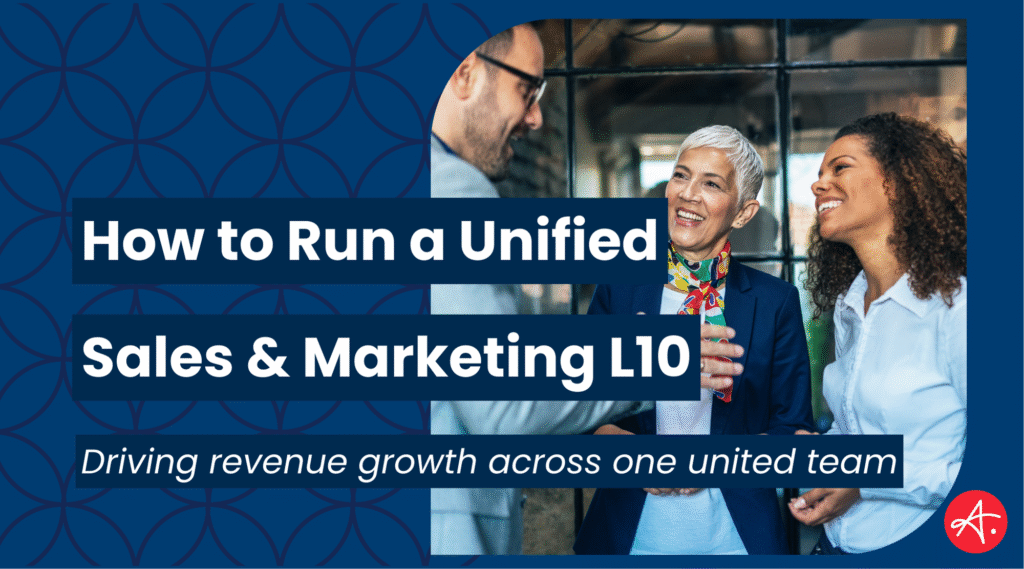Bridging the Gap: How to Run a Unified Sales + Marketing Weekly Cadence Meeting That Actually Moves the Needle

EOS® gives growth-focused businesses a powerful operating system for accountability, clarity, and execution. But when it comes to sales and marketing, there’s a persistent pain point we see again and again:
They share a seat on the Accountability Chart… but rarely share the same strategy, scorecard, or story.
So how do you bring these two critical teams into alignment without adding more meetings to the calendar? By running one powerful, purposeful, and truly collaborative L10 meeting.
A combined L10 meeting needs to be complementary to your team’s structure. For smaller teams, it may make sense to include all sales and marketing team members. For larger teams, it may be necessary to have separate L10 meetings, in which case it’s important to have the joint sales & marketing leader participate in both and bring teams together for a quarterly workshop to capture issues and agree on rocks for the next quarter.
At Authentic®, we’ve helped hundreds of small and mid-sized companies break through the random acts of marketing rut by installing the systems that unify go-to-market execution. And it starts with weekly cadence meetings.
This is a guide specific to hosting one joint L10 for smaller teams, for whom we recommend a single, combined meeting. Let’s walk through how to structure a combined sales + marketing meeting that does more than just reporting and moves toward driving real momentum.
Why combine sales + marketing into one weekly meeting?
In most EOS-run businesses, sales and marketing share a leadership seat. It works well—at least at the start. But as companies grow, this shared seat often gets dominated by sales, while marketing gets reduced to a tactical support function. The result? Reactive campaigns, unclear handoffs, siloed reporting, and friction around what’s working (and what’s not).
When sales and marketing operate in silos, misalignment shows up in a few familiar ways:
- Leads aren’t followed up on (or aren’t qualified to begin with)
- Campaigns go live without sales enablement or context
- Scorecards don’t tell a cohesive revenue story
- Teams blame each other instead of solving problems together
By bringing these functions together in a single, well-run meeting, you lay the foundation for shared understanding, ownership, and outcomes. This is something we currently practice at Authentic in order to keep our sales and marketing teams tightly aligned around sales pipeline activity.
Setting the stage for alignment
Like everything in EOS, success starts with preparation. A combined meeting won’t work if sales and marketing are reporting from different playbooks.
Here’s how to prep for alignment:
- Agree on shared goals and to-dos. While it’s important to have clear ownership of each “Rock” on the 90-day plan, it’s also important to take a “one team” approach. Rather than thinking in terms of separate “marketing rocks” and “sales rocks,” we recommend agreeing on “revenue team rocks”. Outcomes are always stronger when these functions collaborate on business priorities like lead gen, campaign performance, or pipeline acceleration.
- Build a joint scorecard. Highlight leading and lagging indicators across the full funnel—from awareness to revenue. Keep it simple, visual, and actionable.
- Clarify roles and accountability. Make sure that each team member and department knows who’s responsible for what outcome. Who owns campaign development? Who follows up on MQLs? Who’s responsible for conversion rates?
The Sales + Marketing Meeting Agenda (With Revenue in Mind)
When combining sales and marketing into one meeting, we recommend a few smart tweaks that prioritize collaboration, storytelling, and problem-solving. Here’s how the Authentic team currently runs a combined sales + marketing meeting:
1. Check-In (5 min)
Start with shared wins from both teams. Celebrate a successful campaign launch and a big deal closed. This builds trust and connection before diving into metrics. The Authentic team typically shares both a business and personal best.
2. Headlines (10 min)
Each team shares their top headlines of the week – whether that’s upcoming marketing events, a status update on a key deal’s progression, or observations of what’s happening in the market. During this time, the team also may identify issues that need to be addressed during the IDS session later.
3. Metrics + Pipeline Review (20 min)
This is the heartbeat of the meeting—where alignment becomes real (or reveals where it’s lacking). Instead of simply reporting for the sake of it, this section of the meeting should drive shared understanding and proactive decision-making.
Start with your shared scorecard: a simple, visual dashboard that includes key metrics across the full funnel. We recommend tracking a focused set of leading and lagging indicators, such as:
- Marketing-Qualified Leads (MQLs): Are we generating the right volume of leads?
- Sales-Qualified Leads (SQLs): Is lead quality improving? Are the handoffs clear?
- Pipeline Coverage: Do we have enough opportunities to hit future revenue targets?
- Stage Progression: Are deals moving through the pipeline or stalling out?
- Campaign Engagement: Which campaigns are driving real interaction from the right contacts or accounts?
Next, shift into a pipeline walkthrough. Have the sales lead walk the team through open opportunities, highlighting movement, blockers, or deals at risk. This creates an invaluable feedback loop: marketing can hear firsthand what’s resonating (or not), while sales gets context on upcoming campaigns or content that could help move deals forward.
Finally, carve out a few minutes for a quick lead quality conversation. Ask:
- Are we seeing the right types of leads?
- Which channels or campaigns are performing best?
- Where are we losing momentum—and why?
This isn’t about pointing fingers. It’s about co-owning the full funnel, spotting trends early, and staying nimble enough to respond as a unified team.
4. IDS: Identify, Discuss, Solve (20 min)
This is where the magic happens. Use IDS to tackle issues that impact your full revenue engine. Examples:
- “Why is our MQL-to-SQL conversion rate dropping?”
- “Are our paid campaigns targeting the right accounts?”
- “What’s our plan to re-engage cold pipeline leads?”
- “Do we have the right enablement tools for Q4 launches?”
Assign owners, capture to-dos, and move on to the next item on the list.
7. Conclude (5 min)
Recap action items. Confirm owners and due dates. Rate the meeting from 1–10. If the number’s low, ask why—and improve next week.
Don’t Just Share a Seat. Share the Strategy.
Sales and marketing alignment isn’t a one-time workshop. It’s a weekly and daily habit.
A well-run weekly cadence meeting doesn’t just keep teams informed—it keeps them accountable, connected, and collaborative. It turns random acts into repeatable systems. And it turns tactical teams into a unified revenue engine.
Remember: Your buyer doesn’t care who “owns” the lead. They care that your business shows up with clarity, consistency, and value at every touchpoint. Let your weekly cadence meeting become the rhythm that drives that result.
Interested in learning how an Authentic CMO could help your team improve sales and marketing alignment? Contact us today.
